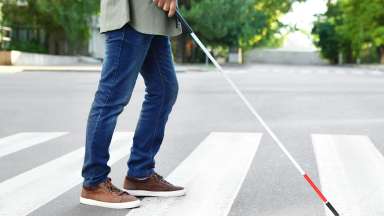Among the things that make Raleigh unique is its diversity. A walk through Raleigh showcases farmers, young tech workers, and seniors enjoying a chess game on Fayetteville Street. Strolling through the city, you'll also notice people using canes and crosswalks as part of their journey. Raleigh is home to the Governor Morehead School for the Blind. We're proud to be a place for those learning to navigate the world differently.
White Cane Awareness Day was first recognized at the White House in 1964. This day honors diversity and focuses on the independence and safety of people who are blind or visually impaired. The white cane is more than a tool for getting around; it stands for the freedom and safety of those with vision loss and lets others know they are there.
In North Carolina, it’s estimated that more than 300,000 people are blind or visually impaired, and many use white canes or guide dogs to help them. State law, NC GS § 20-175.2, says that drivers must give the right-of-way at any crossing to keep pedestrians safe. Failure to comply can result in serious legal consequences.
On this day, we emphasize the importance of respecting the rights of blind individuals by:
- Always yielding to pedestrians using white canes or guide dogs.
- Stopping five feet before crosswalks.
- Being extra cautious with electric or hybrid vehicles.
- Avoiding honking, which can disorient blind pedestrians.
For us in particular, White Cane Day is also a time to recognize the efforts of City government to make the right-of-way more accessible and safer for people with vision loss. There is still much work left to do, but we are pleased at the recent faster pace of improvements for blind or low-vision pedestrians in Raleigh.
Dr. Rick Scott, Raleigh Mayor's Committee for Persons with Disabilities Chairman
White Cane Awareness Day serves as a vital reminder of our shared responsibility to create a safe, inclusive community. By following these guidelines, we honor the resilience and independence of those who navigate the world with a white cane.
Transportation and Accessibility
The City of Raleigh has Accessible Pedestrian Signals (APS) at 101 out of 663 intersections with traffic lights. We want to add APS at the remaining 425 intersections. To do this, we’ll upgrade 15 intersections each year, using APS devices, bright crosswalks, ramps for wheelchairs, and other safety features. This will be done along with upgrades from private developers, state projects, and city projects. Our goal is to have APS at all intersections with pedestrian signals in the next 5 to 10 years.
Our Vision Zero goal is working to reduce and eliminate serious injuries along our transportation network. Learn more!
